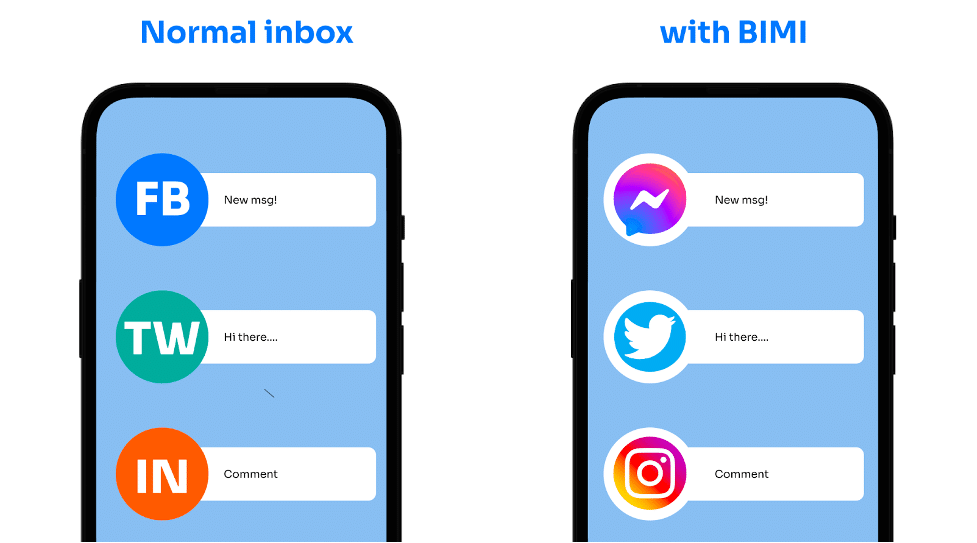Email communication keeps growing despite challenges. Over the years, it has connected people and brands efficiently. But with the growth in technology, cyberattacks are also becoming stronger. It became a need to protect email communication from these attacks.
By this time, the email authentication method keeps on getting released to prevent the emails from being attacked. Brand Indicators for Message Identification (BIMI) is one of those methods. It allows brands to add their brand’s logo to their emails.
According to research, 0.14%, of the world’s top ten million domains have published a BIMI record as of June 2023. Whereas, out of these domains only 10.70% of domains have BIMI with VMC (Certificate).
This article will show you what BIMI is and how implementing it will enhance email communication. Read along to know.
Contents
What is BIMI?
BIMI is an email security standard. It is used to add authentication to your brand’s emails. BIMI adds a brand’s logo to the verified emails to give them an identification. It was founded in 2015 and since then it has risen in popularity as it authenticates brands and keeps users safe. Authindicators Working Group are the one behind it’s creation and success.

With BIMI, email senders can control how the emails show their brands. Brands can use BIMI with the help of email providers. It authenticates their emails by distinguishing them from scam emails. The BIMI logo serves two purposes:
Identification
The addition of personalized badges on the emails marks them as legitimate. Receivers can easily recognize whether the email came from an authentic source. This makes identifying the emails an easier task.
Adds Trust
The BIMI badges on the emails make them look trustworthy. The brand’s logo on the emails makes the recipient satisfied. It shows that email has passed through authentication processes.
Significance of BIMI
You can enhance your email marketing strategy with BIMI implementation. It provides numerous advantages. A few key benefits of BIMI are as follows.
● Boosting Email Security and Authentication
BIMI demands the strong interaction of email authentication protocols like DMARC. Hence, after implementing BIMI, the emails are marked legitimate. The recipients can easily identify genuine emails. Therefore, it makes their inboxes safe from scam emails.
● Increased User Interaction
The emails sent with the brand’s logo catch the recipient’s attraction. It contributes to the increased user engagement. They get familiar with the brand’s identity. BIMI helps build strong communication between the brand and its customers.
● Building Trust and Credibility
As the number of scam emails has increased continuously, users are more concerned about the legitimacy of emails. This issue has been helped with BIMI and other authentication methods. It confirms the source of the emails. Thereby, increasing the trust in the brand.
● Establishing a Visual Brand Identity
Recipients can recognize the emails as soon as they see the BIMI logo. The brand’s logo is less likely to be copied. Even if it does, there are some minor changes in the copied logo. Therefore, BIMI provides a visual recognition that the email is from an authentic brand.
● Possible Deliverability Advantages
Implementation of BMI and authentication protocols increases email deliverability rates. You can show your ESPs that your emails follow authentication protocols. Hence, emails can easily pass the spam filters and are delivered smoothly.
Requirements of a BIMI Logo
BIMI is not required necessarily for all organizations. Buy implementing increases the brand’s credibility. It helps the recipients identify the brand. Here are some basic requirements for a BIMI.
DMARC and DKIM Implementation
Before implementing BIMI, one must add DKIM and DMARC to the domain. The email authentication protocols help identify the legitimacy of the emails. BIMI works best for domains verified with DMARC, DKIM, and SPF protocols.
Brand’s Ownership
The email address must be associated with the domain you own. BIMI is for authentic businesses. So, domain ownership is essential to display the domain’s logo. The owner must have control over the domain’s DNS record.
Host Your Logo
Your brand’s logo must be accessible on the public web server. Before implementing BIMI, make sure your logo is only accessible from a specific URL. You can check your DNS record to find this information. It is recommended to follow the correct format for acceptance of Logo. It must meet the BIMI’s technical requirements.
Follow BIMI’s Guidelines
For the logo authentication, it must follow BIMI’s guidelines. It must be in the recommended size and contain the brand’s approval. The logo must not mislead the user. It must also follow the size and aspect ratio.
Setting Up BIMI
For the implementation of BIMI, one must keep various factors in consideration. If you want to make your emails authentic with BIMI, here’s a guide for you.
1. Assess Your Readiness
Before implementing BIMI, check your email infrastructure. Your domain’s email must have SPF, DKIM, and DMARC implementation. These email authentication protocols act as a basis for the implementation of BIMI. Implementation of the authentication protocols works as a ground for increasing the brand’s visibility and trustworthiness.
2. Verify Your Domain
Review your email authentication goals. Use and implement DMARC policies that align with your authentication goals. The DMARC policies must be regularly updated to make your email ecosystem favorable for BIMI implementation.
3. Secure Your Trademark
Get a trademark for your brand. Register it before displaying your brand’s logo. Trademark works only for legitimate businesses. So by registering it, your brand can implement BIMI. Trademark registration lets you gain legal protection against unauthorized use of the brand’s logo. This prevents your customers from getting confused by fake brands.
4. Obtain a Verified Mark Certificate (VMC)
Get a VMC by working with an authorized Certification Authority. A VC verifies the ownership of the brand’s logo by providing a certificate. VMC helps in the smooth implementation of BIMI.
5. Publish Your BIMI Records
After you receive the VMC, carefully publish the BIMI record. This record should be published in your domain’s DNS. The BIMI record has all the information about the VMC and your brand’s identity. BIMI record with VMC It helps email clients find and show your logo.
6. Monitor and Sustain
Keep an eye on email authentication failures. Maintenance of the domain and associated protocol is more important for business growth. Update your DMARC reports and BIMI records regularly. Add the changes in your brand’s domain and logo.
BIMI Interaction with DMARC, DKIM, and SPF
As mentioned above, the implementation of DMARC before BIMI is essential. DMARC is stored as a TXT record. DMARC’s policy must be preset to p=quarantine or p=reject for all the emails sent from the domain. After the implementation of DMARC, it can work with BIMI.
DMARC is the requirement for the BIMI implementation. In the same way, DMARC works with the integration of SPF and DKIM. SPF records must be added to enhance security while using BIMI. DKIM along with SPF are also stored with DMARC as TXT records on your domain.
Conclusion
In the evolving digital world, a business needs to stand out. This can be helped with authenticating the brand and its way of communication. BIMI helps in email authentication along with DMARC. To utilize BIMI, organizations show strict compliance with security protocols.
The brand’s logo not only enhances security but also increases the brand’s recognition. Recipients trust the brand after witnessing an authentic logo on their emails. You must implement DMARC on your domain to get started with BIMI. PowerDMARC can help you with the DMARC’s implementation.

